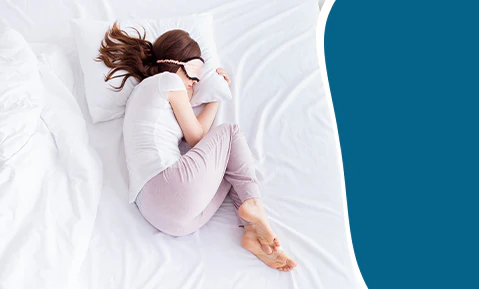Introduction to Sleep and Personality
Understanding the interplay between sleep and personality can offer profound insights into our inner selves. While often overlooked, the way we sleep—ranging from our preferred sleep positions to our nightly routines—can be indicative of underlying personality traits. This blog aims to delve into these connections, providing a comprehensive exploration of how our sleep habits can reflect and even shape who we are.
Sleep is a universal experience, yet it is uniquely individual. From the fetal position to lying flat on our backs, each sleep posture can reveal nuances about our emotional state and character. For instance, some studies suggest that those who sleep on their sides may be more open and welcoming, while back sleepers might exhibit confidence and a strong sense of self. Moreover, our sleep routines, such as the time we choose to go to bed and how we prepare for sleep, can also provide clues about our daily priorities and stress levels.
The purpose of this blog is not just to inform but to engage you in a self-reflective journey. By understanding the science and psychology behind sleep habits, you can gain a clearer picture of your own personality and how it manifests in your day-to-day life. Whether you are a night owl who thrives in the late hours or an early bird who rises with the sun, your sleep patterns are more than just habits—they are windows into your personality.
As we proceed through the following sections, we will break down various sleep positions and routines, linking them to specific personality traits. Through this exploration, you may find yourself recognizing familiar patterns or discovering new aspects of your character. Ultimately, this knowledge can empower you to make more informed choices about your sleep, enhancing both your well-being and self-awareness.
The Science Behind Sleep Positions
Understanding the relationship between sleep positions and personality traits is a fascinating intersection of psychology, neuroscience, and behavioral science. Various scientific studies and psychological theories have explored this connection, providing a credible foundation for the idea that how we sleep can reveal aspects of our personality.
One of the seminal studies in this field was conducted by Professor Chris Idzikowski, a renowned sleep researcher. His research indicates that certain sleep positions are commonly associated with specific personality traits. For instance, individuals who favor the fetal position—curled up on their side—are often described as having a tough exterior but a sensitive inner self. Conversely, those who sleep on their back with arms at their sides, also known as the soldier position, tend to be reserved and quiet but maintain high standards for themselves and others.
Further supporting these findings, a study published in the Journal of Research in Personality explored the link between sleep positions and the Big Five personality traits: openness, conscientiousness, extraversion, agreeableness, and neuroticism. The research showed that people who sleep in the log position, lying on their side with their arms close to the body, are generally more social and easy-going, aligning with higher levels of extraversion and agreeableness. On the other hand, those who sleep in the starfish position, lying on their back with arms and legs spread out, often exhibit traits of openness and a supportive nature.

Psychological theories also contribute to this understanding. Attachment theory, for example, suggests that our sleep positions may mirror the attachment styles we developed in childhood. Securely attached individuals are more likely to adopt relaxed sleep positions, whereas those with anxious or avoidant attachment styles may display more curled or rigid postures.
Incorporating these scientific and psychological perspectives provides a robust framework for the idea that our sleep habits are more than just a nightly routine; they are a window into our inner selves. These insights not only deepen our understanding of the human psyche but also offer practical applications in improving sleep quality and mental health.
Common Sleep Positions and Their Meanings
Sleep positions can provide intriguing insights into one’s personality traits and characteristics. Understanding these common sleep positions can help individuals become more aware of their subconscious tendencies and behaviors. Here, we explore some of the most prevalent sleep positions and their associated meanings.
Fetal Position
The fetal position, where an individual curls up on their side with knees drawn towards the chest, is one of the most common sleep positions. People who sleep in this position are often described as having a tough exterior but a sensitive inner self. They may appear shy initially but tend to warm up quickly and become more relaxed and sociable. The fetal position suggests a need for comfort and security, akin to a sense of retreating to a safe and familiar place.

Log Position
In the log position, individuals sleep on their side with both arms down by their sides. This position is typically associated with easygoing and sociable personalities. People who sleep in the log position are often considered trustworthy and open to new experiences. However, they may also be perceived as somewhat gullible due to their trusting nature.

Yearner Position
The yearner position involves sleeping on one’s side with arms extended out in front, as if reaching for something. Individuals who favor this position are often seen as open-minded yet cynical. They may be slow to make decisions but are resolute once their minds are made up. This position reflects a balance between openness to new ideas and a cautious approach to life.

Soldier Position
The soldier position, where an individual sleeps on their back with arms close to the body, is linked to people who have a strong sense of duty and self-discipline. Those who prefer this position are often quiet and reserved, setting high standards for themselves and others. They value structure and order, aiming for excellence in various aspects of life.

By examining these common sleep positions, one can gain valuable insights into the underlying personality traits that shape behaviors and interactions. Understanding these connections can foster greater self-awareness and lead to more meaningful personal growth.
How Sleep Quality Affects Personality Insights
The quality of sleep plays a pivotal role in the accuracy of personality insights derived from sleep positions. Good sleep hygiene is essential for ensuring that the body and mind are well-rested, which in turn allows for more reliable interpretations of personality traits. Factors such as stress, environment, and lifestyle significantly influence sleep patterns, and these elements can alter the way sleep positions are perceived in relation to personality.
Stress is a major disruptor of sleep quality. High stress levels can lead to fragmented sleep, frequent awakenings, and difficulty falling asleep, all of which can mask true sleep positions and, consequently, distort the personality insights drawn from them. For instance, a person under significant stress might adopt a fetal position more frequently due to a subconscious need for comfort and security, potentially leading to an inaccurate interpretation of this position as a permanent personality trait rather than a temporary response to stress.
The sleep environment also plays a critical role in determining sleep quality. Factors such as room temperature, noise levels, and bed comfort can either enhance or hinder the ability to maintain a consistent sleep position. An optimal sleep environment promotes deeper, uninterrupted sleep, which is crucial for obtaining accurate personality insights. A person sleeping in a noisy or uncomfortable environment may shift positions frequently, leading to less reliable data on their natural sleep tendencies.
Lifestyle choices, including diet, exercise, and screen time, are closely linked to sleep quality and patterns. Poor lifestyle habits can result in irregular sleep schedules and diminished sleep quality, affecting the consistency of sleep positions. For example, excessive screen time before bed can delay sleep onset and alter normal sleep cycles, thereby impacting the overall accuracy of personality insights derived from sleep habits.
In essence, the accuracy of personality insights from sleep positions is heavily dependent on achieving high-quality sleep. By prioritizing good sleep hygiene and managing stress, optimizing the sleep environment, and adopting healthy lifestyle habits, individuals can ensure that their sleep patterns reflect their true personality traits more accurately.
Personalizing Your Sleep Analysis
Understanding your sleep habits is an essential step toward unlocking insights about your personality. To begin personalizing your sleep analysis, start by observing and analyzing your own sleep positions and habits. One of the most effective ways to track these patterns is by maintaining a sleep journal. Each morning, take a few minutes to jot down details about your sleep, such as the position you fell asleep in, any changes throughout the night, and how rested you feel upon waking. Consistency is key; the more data you collect, the clearer the patterns will become.
In addition to a sleep journal, sleep-tracking apps can offer a more detailed analysis. These apps use sensors in your smartphone or wearable devices to monitor your movements and sleep cycles, providing insights into your sleep quality and duration. By regularly reviewing this data, you can identify trends and make informed adjustments to improve your sleep hygiene.
Self-awareness plays a critical role in this process. Recognize how various factors, such as stress, diet, and physical activity, influence your sleep. Being mindful of these connections can help you make better lifestyle choices that promote healthier sleep patterns. Moreover, it is important to track your sleep data consistently over time. Sporadic entries or inconsistent tracking can lead to inaccurate conclusions, so make it a habit to record your observations daily.
| Sleep Habit | Personality Insight | Explanation |
|---|
| Early Bird | Disciplined, Productive, Proactive | Early risers often have structured routines and are proactive in their daily tasks. |
| Night Owl | Creative, Independent, Introspective | Night owls are typically more creative and enjoy solitude, often finding inspiration during late hours. |
| Light Sleeper | Sensitive, Anxious, Detail-Oriented | Light sleepers may be more sensitive to their environment and attentive to details, but also prone to anxiety. |
| Deep Sleeper | Relaxed, Easy-going, Resilient | Deep sleepers tend to be more relaxed and resilient, handling stress with ease and maintaining calm. |
| Consistent Sleep Schedule | Organized, Reliable, Health-Conscious | Maintaining a regular sleep schedule reflects a person’s commitment to health and reliability. |
| Irregular Sleep Patterns | Spontaneous, Flexible, Unpredictable | Those with irregular sleep patterns are often more spontaneous and adaptable but may struggle with routine. |
| Short Sleeper | High Energy, Ambitious, Overworked | Short sleepers may have high energy and ambition but risk burnout due to insufficient rest. |
| Long Sleeper | Introverted, Reflective, Needs Rejuvenation | Long sleepers often require more downtime to recharge, indicating a reflective and introverted nature. |
| Frequent Naps | Creative, Flexible, Needs Breaks | Frequent nappers often have creative bursts and need regular breaks to maintain productivity and focus. |
| Difficulty Falling Asleep | Worrier, Perfectionist, High-Stress | Difficulty in falling asleep may indicate a tendency to worry and strive for perfection, leading to high stress. |
By personalizing your sleep analysis, you equip yourself with valuable information that can enhance your overall well-being. Pay attention to the details, use technology to your advantage, and remain consistent in your efforts. With these practical tips, you’ll be well on your way to uncovering the secrets your sleep habits reveal about your personality.
Real-Life Examples and Case Studies
Understanding sleep habits can reveal significant insights about one’s personality. Consider the case of Sarah, a marketing executive who often found herself waking up exhausted. After consulting a sleep specialist, she discovered that her sleep position was contributing to her discomfort. Sarah habitually slept in a fetal position, which is known to indicate a need for comfort and security. By recognizing this trait, Sarah was able to address underlying stressors in her life, leading to improved sleep quality and an enhanced sense of well-being.
Another compelling example is John, a software developer who struggled with chronic back pain. John typically slept on his stomach, a position known for its potential to cause spinal issues. Upon learning that this position often signifies a strong-willed and risk-taking personality, John decided to experiment with back sleeping. This transition not only alleviated his back pain but also led him to explore relaxation techniques that complemented his assertive nature, thereby boosting his overall productivity and mental health.
Then there’s Emily, a college student who noticed a pattern of restlessness in her sleep. Emily discovered she was a side sleeper, which is often associated with a balanced and easy-going personality. By understanding this, Emily took steps to create a more calming sleep environment, such as eliminating electronic devices from her bedroom and practicing mindfulness before bed. These changes resulted in a more restful sleep and a noticeable improvement in her academic performance and emotional stability.
These real-life examples underscore the practical benefits of understanding the relationship between sleep habits and personality. By recognizing the nuances of their sleep positions, individuals like Sarah, John, and Emily have made meaningful changes that positively impact their daily lives. This awareness not only enhances sleep quality but also fosters a deeper understanding of their own behavioral patterns and characteristics.
Sleep Positions and Relationship Dynamics
Sleep positions can serve as a window into the dynamics of a relationship, offering subtle clues about the emotional and psychological states of both partners. Various common sleep positions for couples may reveal different aspects of relationship health and individual personalities. For example, the “spooning” position, where one partner encloses the other from behind, is often seen as a sign of protection, intimacy, and trust. Conversely, couples who sleep back-to-back but still maintain physical contact might indicate a balanced relationship where both partners enjoy a sense of independence while remaining connected.
Another notable sleep position is the “tangled” position, where couples fall asleep in an intertwined embrace but may separate during the night. This position often signifies a strong emotional connection and passionate relationship but also hints at a healthy balance of closeness and independence. On the other hand, sleeping on opposite sides of the bed without any physical contact might suggest underlying issues or a need for personal space, which does not necessarily indicate trouble but could be an area for improvement.
Understanding these nuances can help couples work towards enhancing both their sleep quality and relationship harmony. Here are some tips for couples looking to improve their sleep environment and strengthen their bond:
1. Prioritize Comfort: Invest in a comfortable mattress and pillows that cater to both partners’ preferences. This ensures that neither partner’s sleep is compromised, leading to better rest and less tension.
2. Establish a Routine: Going to bed and waking up at the same time can align sleep cycles and foster a sense of togetherness. This routine can also help in synchronizing other daily activities, promoting a more harmonious relationship.
3. Communicate Openly: If one partner feels uncomfortable with the current sleep position, discussing it openly can lead to adjustments that benefit both parties. Mutual respect and understanding can mitigate potential conflicts over sleep habits.
4. Create a Calming Environment: A tranquil bedroom setting with minimal distractions can enhance the quality of sleep. Consider elements like soothing colors, ambient lighting, and reducing noise to create a serene atmosphere conducive to restful sleep.
By paying attention to sleep positions and making conscious efforts to improve the sleeping environment, couples can not only enjoy better quality sleep but also fortify their emotional and relational bonds.
Frequently Asked Questions
Understanding the relationship between sleep positions and personality traits can be intriguing. Below, we address some common questions to provide clarity on this subject.
Can my sleep position change over time?
Yes, your sleep position can indeed change over time. Various factors, such as age, physical health, and psychological state, can influence how you sleep. For example, a person who once favored sleeping on their stomach might transition to a side or back sleeping position due to different comfort needs or health recommendations. It’s essential to listen to your body and adjust your sleep habits accordingly to ensure restful and restorative sleep.
Is there a best sleep position for health?
While there isn’t a universally ‘best’ sleep position, certain positions can offer specific health benefits. Sleeping on your back is often recommended for spine alignment and reducing acid reflux. Side sleeping is beneficial for reducing snoring and can be helpful during pregnancy. However, it’s crucial to consider individual needs and comfort levels. Consulting with a healthcare provider can help determine the most suitable sleep position for your particular health concerns.
How can I improve my sleep habits?
Improving sleep habits involves several practical steps. Firstly, establish a regular sleep schedule by going to bed and waking up at the same time each day. Create a relaxing bedtime routine, such as reading or taking a warm bath, to signal your body that it’s time to wind down. Ensure your sleep environment is conducive to rest by keeping the room dark, quiet, and cool. Additionally, be mindful of your diet and avoid caffeine or heavy meals close to bedtime. Incorporating these strategies can significantly enhance the quality of your sleep, leading to better overall well-being.





Thanks I have recently been looking for info about this subject for a while and yours is the greatest I have discovered so far However what in regards to the bottom line Are you certain in regards to the supply
I loved as much as you will receive carried out right here The sketch is tasteful your authored subject matter stylish nonetheless you command get got an edginess over that you wish be delivering the following unwell unquestionably come further formerly again as exactly the same nearly very often inside case you shield this hike